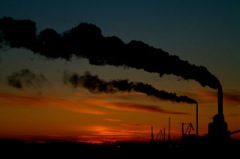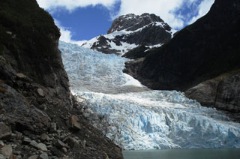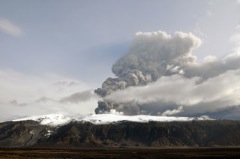Six popular fallacies on climate change
|
|
1. Earth's climate is always changing and even during the past hundred thousand years earth was warmer. Humankind has therefore no influence on the occurrence of warmer periods. Throughout history the world has experienced warmer and colder periods (ice ages and inter-glacials) without human interference. The Earth's climate is very complex and a superposition of certain external and internal factors, i.e. the declination of the Earth's axis, eccentricity of the Earth's orbit around the sun, greenhouse gas release and trapping by volcanism and plate tectonics and weathering. These factors humankind can not influence. It is well-known (Milankovitch 1920) that e.g. the change between ice ages and inter-glacials are triggered by changes in orbital settings which also cause changes of global temperature and carbon dioxide (CO2) concentration in the atmosphere. Both factors are closely interconnected. When oceans grow warmer they release carbon dioxide inducing an additional warming (positive feedback), while when they cool their potential uptake of CO2 increases, inducing a positive feedback. These mechanisms are not in contradiction with greenhouse gas theory (cf. fallacy 2). The natural greenhouse gas effect actually made the Earth into livable planet. Humankind itself became a planetary factor, because it contributed to an increasing of CO2 emissions by 36% within the last 150 years. It is very unlikely for this increase to pose no influence on the Earth's condition. One needs to clearly distinguish between climate on geo-historical time scales and anthropogenic induced changes of the climate. | |
|
|
2. Carbon dioxide is only a minor compound of the atmosphere and cannot account for global warming. Other gases like water vapor are much more prominent and responsible for global warming. Water vapor is the most relevant greenhouse gas (95%), and it is scientific consensus that anthropogenic greenhouse gas forcing accounts to only 2-3% of the natural forcing (see IPCC 2007). But contrary to CO2, water vapor remains in the atmosphere for only a few days and is then released as precipitation. The total (natural) greenhouse effect was already discovered and described in the 18th century1, and can be easily calculated (by the help of the Stefan-Boltzman law (1879/1884) ). The natural greenhouse effect amounts to appr. 33 °C. The greenhouse gases released by humankind are subordinated under the same mechanisms as the naturally released greenhouse gases. A rough estimate shows that 2-3% of 33 °C is very similar to what the IPCC has been stated about human induced anthropogenic warming (0.66-0.99 °C vs. ~0.74 ± 0,18 °C). The additional, anthropogenic warming is amplified because it also drives water vapor into the atmosphere, and because a warmer atmosphere can carry more water than a cooler atmosphere. | |
|
|
3. The global community of climate scientists has agreed on the existence of climate change in order to sustain funding for research and in order to gain money from new technologies. IPCC reports are political documents, but do include state of the art knowledge on climate change. Each comment published in these reports has undergone multiple instances of scientific reviews of independent colleagues. Furthermore, most of the results in these reports were published in several journals before and are likewise reviewed. The fact that a few colleagues have contradictory opinions shows that the mechanism works. | |
|
|
4. Earth is not entering a warmer phase, but a new ice age. Considering the development of the climate in the last 600.000 years we are currently experiencing a warm period (inter-glacial) of the Holocene. Considering Milankovitch (cf. fallacy 1) it is likely that the next geological era will be an ice age. When this will happen remains unclear and the time span is rather long in comparison to the time span of processes that are subsumed under human induced climate change. Human interference with climate will occur at least 10 times more rapid than the temperature change at the end of the last ice age and effects will occur on a much shorter time scale as compared to geohistoric time scales. The question remains, whether nature and society can adapt to those rapid changes. | |
|
|
5. Climate models are not reliable in forecasting the climate development for the next 100 years None of the modern climate models is able to forecast climate development. A climate model is only an approximation of reality (which holds for all models). In other words, climate models can not represent each detail of the climate system. But the current generation of climate models has become increasingly accurate and is able to demonstrate how climate works. One important criterion for their validity is the fact that climate models are able to reconstruct the past. The climate of the future depends on current and future human decisions. Thus, modern climate models provide if-then projections based on certain assumptions about human development, such as population growth rates or whether clean technologies are implemented very rapidly or not. While the physical basis of the climate system is well understood, the impossibility of exactly forecasting human development introduces considerable uncertainty into model projections and is one reason why science provides different pathways of development. | |
|
|
6. Volcanic eruptions are emitting much more carbon dioxide than humankind During the evolution of the earth throughout billions of years, volcanic activity has been much higher, as has been the concentration of atmospheric CO2.This activity slowed down during the geohistoric development and 4 billion years ago the atmospheric composition consisted of 80% water vapor, 10% CO2, and other trace gases. Further cooling of the planet lead to heavy rainfall, which filled the oceans. 3.5 billion years ago the first cyanobacteria started photosynthesis and reduced the carbon dioxide concentration. Today, volcanic activity remains constant and at a lower level as on early Earth. CO2 emissions from volcanic eruption now amount to approx. 1-2% of that what is currently released by humankind. |





